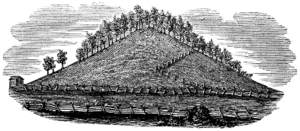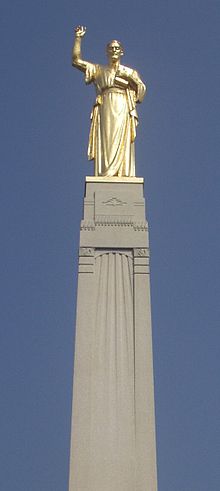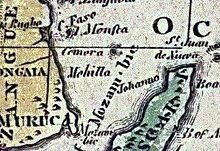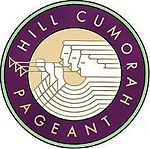- Cumorah
-
Cumorah (also known as Mormon Hill,[1][2][3] Gold Bible Hill,[4][5] and Inspiration Point)[1] is a drumlin in Manchester, New York, where Joseph Smith, Jr. said he found a set of gold plates which he translated into English and published as the Book of Mormon.
In the text of the Book of Mormon, "Cumorah" is a hill located in a land of the same name, which is "a land of many waters, rivers and fountains".[6] In this hill Book of Mormon figure Mormon deposited a number of metal plates containing the record of his nation of Nephites,[7] just prior to their final battle with the Lamanites in which at least 230,000 people were killed.[8]
Early Latter Day Saints assumed that the Cumorah in New York was the same Cumorah described in the Book of Mormon, but in the early-20th century, scholars from the Reorganized Church of Jesus Christ of Latter Day Saints (RLDS Church) and The Church of Jesus Christ of Latter-day Saints (LDS Church) began to speculate that there were two such hills and that final battle in the Book of Mormon took place on a hill in southern Mexico, Central America, or South America.[9] The LDS Church has no official position on the matter[10] and these hypotheses are not held by some leaders and members of the LDS Church[11] but firmly espoused by others.[12]
Contents
New York
The hill named Cumorah in Manchester, New York (coordinates: 43°00′22″N 77°13′26″W / 43.0062°N 77.224°WCoordinates: 43°00′22″N 77°13′26″W / 43.0062°N 77.224°W) is thought to be where Smith discovered the gold plates which contained the writings of the Book of Mormon. Smith wrote: "On the west side of this hill, not far from the top, under a stone of considerable size, lay the plates, deposited in a stone box."[13]
Smith visited the hill each year on September 22 between 1823 and 1827 and was instructed by a "holy messenger", who Smith identified as Moroni.[13] Smith was finally allowed to take the record on September 22, 1827.[13] Eleven other men gave written testimony that they had also seen them and held them in their hands. [14]
The hill, which was unnamed prior to 1829, is situated a few miles from Joseph Smith's boyhood home on a farm that was then owned by a local farmer, Alonzo Sanders. This farm was 4 miles (6.4 km) south of Palmyra, on the main road toward Canandaigua from Palmyra to Manchester, and is not far from Carangrie Creek and the Clyde River. According to geologists, the hill was formed during the retreat of the Ice Age glaciers, and it rises approximately 110 feet (34 m) above the surrounding valley floor.
Since 1829, the Latter Day Saints have called the hill "Cumorah",[15] and local non-Mormons have called it "Mormon Hill"[1][2][3] or "Gold Bible Hill".[5] The hill has also been called "Inspiration Point".[1] The hill and surrounding land was purchased in the 1920s by the LDS Church under the direction of Church President Heber J. Grant. The transaction involved two separate purchases: the purchase of the "Inglis farm"; and the purchase of the "Sexton farm". The Inglis farm consisted of 96 acres (39 ha) on both sides of the Canandaigua–Palmyra road and encompassed one third of the western edge of the hill. The 187-acre (76 ha) Sexton farm was purchased from the heirs of Pliny T. Sexton, who owned the "Mormon Hill farm" encompassing the remainder of the hill.[2]
The LDS Church has constructed a monument that is topped with a gold statue of the Angel Moroni on the top of the hill, and there is a visitor's interpretative center at the base of the hill.
Book of Mormon
Nephites
In the Book of Mormon, Cumorah is mentioned in six verses, five in Chapter 6 and one in Chapter 8 of a subpart of the book, which is also known as the Book of Mormon. According to the record, Mormon is the caretaker of the records of his people, which are written on gold plates. His people, called the Nephites, were near to being destroyed by the Lamanites who had had many previous wars with the Nephites. Mormon wrote to the leader of the Lamanites to ask that he may gather his "people unto the land of Cumorah, by a hill which was called Cumorah, and there we could give them battle."[16] Cumorah is described as being in a land with "many waters, rivers, and fountains".[17]
The leader of the Lamanites agreed, and all of the Nephites gathered together, including their women and children. Mormon wrote, "And when three hundred and eighty and four years had passed away [since the sign of the birth of Christ], we had gathered in all the remainder of our people unto the land of Cumorah."[18] Mormon then hid all of the records of his people in the hill, except for the plates that he was currently writing on, which he gave to his son Moroni.[19]
The Lamanites then attacked the Nephites, who were led by twenty-three men each with ten-thousand men under their command.[20] Mormon recorded that all but 24 of the Nephites had been killed, "even all my people, save it were those twenty and four who were with me", except for those who fled to the south or defected to the Lamanites.[21]
Mormon then records his mourning for his people and a last message to those who will read his record later, then again turns the unburied records over to his son Moroni. Moroni records, "after the great and tremendous battle at Cumorah, behold, the Nephites who had escaped into the country southward were hunted by the Lamanites, until they were all destroyed. And my father also was killed by them, and I even remain alone to write the sad tale of the destruction of my people."[22]
Jaredites
This hill, known as "Cumorah" among the Nephites, was called "Ramah" by the Jaredites:
In the Book of Mormon, during the time of the Book of Alma, this land (of Cumorah) was part of the land of Desolation, "the land which had been peopled and been destroyed, of whose bones we have spoken". This land is identified as being north of the land of Zarahemla.[23]
Moroni lived several years after recording the destruction of his people. He translated and abridged the plates which were the record of the Jaredites as the Book of Ether on to the plates that he was keeping. During this process, he wrote, "Omer ... passed by the hill of Shim, and came over by the place where the Nephites were destroyed,"[24] and "... it came to pass that the army of Coriantumr did pitch their tents by the hill Ramah; and it was that same hill where my father Mormon did hide up the records unto the Lord, which were sacred."[25] These passages identify the Nephite hill Cumorah as the same hill where the Jaredites had fought their final battle.
Geography and historicity
Since the early-20th century, there has been discussion within the Latter Day Saint movement about whether Hill Cumorah in New York is the same place described in the Book of Mormon, or whether there are two hills of the same name—one in New York and one in either Southern Mexico, Central America, or South America.[9] Mormon archeologists overwhelmingly favor the "two Cumorahs" theory, while conservative theologians and some leaders prefer the view that only one Cumorah exists. Some non-Mormon scholars have provided alternative theories for the origin of the name Cumorah.
New York hill
At least ten different accounts refer to certain events that occurred at the hill Cumorah in New York.[26] According to the account of Brigham Young, the angel instructed Joseph Smith to carry the gold plates back to the hill Cumorah. When Smith and Oliver Cowdery arrived, "the hill opened, and they walked into a cave, in which there was a large and spacious room." The account continues by saying they found "more plates than probably many wagon loads; they were piled up in the corners and along the walls." When they first entered, the Sword of Laban was hanging on the wall. When they re-entered later, the Sword of Laban was unsheathed and resting on top of the newly delivered gold plates. The sword had an inscription on it that said the sword "will never be sheathed again until the kingdoms of this world become the kingdom of our God and his Christ."[27] It has been suggested by Mesoamerican Cumorah advocates that these events occurred in a vision rather than a physical visit.[28]
There has been no on-site archaeological research at Cumorah in New York.
Cerro Vigia
Mormon scholars have proposed the "Cerro Vigia" (coordinates: 18°33′N 95°11′W / 18.55°N 95.183°W or 18°27′25″N 95°21′01″W / 18.45694°N 95.35028°W ) in Veracruz, Mexico, as the hill Cumorah in the Book of Mormon for a variety of reasons. John L. Sorenson has listed 15 cultural criteria for the hill Cumorah which are based on contextual clues from the text of the Book of Mormon: cities, towers, agriculture, metallurgy, formal political states, organized religion, idolatry, crafts, trade, writing, weaponry, astronomy, calendar systems, cement, and wheels. Sorensen alleges that the hill in New York at least partly fits four of these requirements while the Cerro Vigia meets all of them.[29]
Alternative origin of the name
Some scholars have theorized that Smith created the name "Cumorah" through his study of the treasure-hunting stories of Captain William Kidd.[30] Because Kidd was said to have buried treasure in the Comoros islands, it has been suggested that Smith used the name of the islands and applied it to the hill where he found buried treasure—the gold plates.[31] Complementing this proposal is the theory that Smith borrowed the name of a settlement in the Comoros—Moroni—and applied it to the angel which led him to the gold plates.
Mormon apologists have argued that this line of argument commits the logical error of appeal to probability. They also point out that it is highly unlikely that Smith had access to material which would have referred to the then-small settlement of Moroni, particularly since it did not appear in most contemporary gazetteers.[32] However, other Mormon authors have suggested that the ancestors of the Nephite people may have encountered the Comoros islands on their initial voyage from the Arabian Peninsula to the western hemisphere, and that the Nephite civilization therefore may have retained a collective knowledge of the names "Comoros" and "Moroni".[33]
Mainstream archaeological view
Mainstream scholars who specialize in 19th-century American literature place the original literary setting for the Book of Mormon among the mythic mound builder people of North America.[34] Accepting the mound-builder setting, at least one Mormon researcher has pointed out that no Central or South American setting for the Book of Mormon is likely to be accepted by mainstream academia as a legitimate source of Joseph Smith's gold plates.[35] Coon cites non-Mormon archaeologist Salvatore Trento, who posits the possibility that Smith actually discovered buried metal tablets engraved with "weird markings".[36] Trento notes comparable discoveries in Northeastern America which Coon points out are not likely the result of a singular ancient individual traveling thousands of miles from Central or South America to Upstate New York.[37] According to Trento, such finds are consistent with the 19th-century "mound builder" literary setting in which the Book of Mormon is classed by non-Mormon specialists.[38]
Pageant
See also: List of pageants of The Church of Jesus Christ of Latter-day SaintsCurrently, the 283-acre (1.15 km2) site near Palmyra, New York, hosts the annual "Hill Cumorah Pageant".[39] This large, outdoor Latter-day Saint pageant typically occurs in early July and is free to the public.[40]
The pageant can trace its history back to 1935. The current title, America's Witness for Christ, was first used in 1937. This was a play by H. Wayne Driggs that remained the basic text of the pageant until 1987. The 1987 revision, which is still used, was written in large part by Orson Scott Card.[41]
Notes
- ^ a b c d A. P. Kesler, "Mormon Hill", Young Woman's Journal, 9:73 (Feb. 1898).
- ^ a b c "Thomas Cook History, 1930", in Dan Vogel ed. (2000). Early Mormon Documents, vol. 3 (Salt Lake City: Signature Books ISBN 1560851333) pp. 243–250.
- ^ a b Andrew Jenson, Conference Report (April 1917) p. 99.
- ^ "A Looked-for Exposure: Secrets of the Original Mormon Bible", New York Times, 1888-02-26.
- ^ a b Bruce E. Dana (2003). Glad Tidings Near Cumorah (CFI, ISBN 978-1555177232) pp. 58–60.
- ^ Mormon 6:4
- ^ Mormon 6:6. The plates that Mormon buried were the plates he had abridged into what he called the "Book of Mormon". This smaller set of plates were not buried by Mormon but were given to Mormon's son Moroni.
- ^ Mormon 6:11-15
- ^ a b Roper, Matthew, “Limited Geography and the Book of Mormon: Historical Antecedents and Early Interpretations”, Maxwell Institute, 2004, cites early Limited Mesoamerican settings for the Book of Mormon advanced by Hills, L. E. (RLDS), “Geography of Mexico and Central America from 2234 B.C. to 421 A.D.”, Independence, MO, 1917; Hills, “A Short Work on the Popol Vuh and the Traditional History of the Ancient Americans”, Independence, MO, 1918; and Hills, “New Light on American Archaeology”, Independence, MO, 1924; and also Gunsolley, J. F. (RLDS), “More Comment on Book of Mormon Geography”, Saints Herald, Vol. 69, No 46, 1922, pp. 1074-1076. See also the South American setting proposed by Priddis, Venice (LDS), The Book and the Map, 1975, Ch. 11, “Mormon, Moroni and Cumorah”, pp. 153-157.
- ^ [1], Correspondence from F. Michael Watson, 23 April 1993, Cited with commentary in William J. Hamblin, "Basic Methodological Problems with the Anti-Mormon Approach to the Geography and Archaeology of the Book of Mormon," Journal of Book of Mormon Studies 2/1 (1993): 161–197, accessed 13 September 2009. See also Book of Mormon geography/Statements/First Presidency Letter on the FAIR LDS Wiki
- ^ On the subject of a Mesoamerican Cumorah, apostle Joseph Fielding Smith wrote in 1956:
Elder Mark E. Petersen stated:It is known that the Hill Cumorah where the Nephites were destroyed is the hill where the Jaredites were also destroyed. This hill was known to the Jaredites as Ramah. It was approximately near to the waters of Ripliancum, which the Book of Ether says, 'by interpretation, is large or to exceed all.' ... It must be conceded that this description fits perfectly the land of Cumorah in New York ... for the hill is in the proximity of the Great Lakes, and also in the land of many rivers and fountains. (Doctrines of Salvation, vol. 3, pp. 233–234).
Elder Bruce R. McConkie wrote:I do not believe that there were two Hill Cumorahs, one in Central America and the other one up in New York, for the convenience of the Prophet Joseph Smith, so that the poor boy would not have to walk clear to Central America to get the gold plates. (123rd Annual Conference of the Church, April 4–6, 1953, General Conference Report, pp. 83-84; or Improvement Era, June 1953, p. 423)
Both the Nephite and the Jaredite civilizations fought their final great wars of extinction at and near the Hill Cumorah (or Ramah as the Jaredites termed it), which hill is located between Palmyra and Manchester in the western part of the state of New York ... Joseph Smith, Oliver Cowdery, and many early brethren, who were familiar with the circumstances attending the coming forth of the Book of Mormon in this dispensation, have left us pointed testimony as to the identity and location of Cumorah or Ramah. (Mormon Doctrine, s.v. “Cumorah”, p. 175)
- ^ William J. Hamblin, "Basic Methodological Problems with the Anti-Mormon Approach to the Geography and Archaeology of the Book of Mormon," Journal of Book of Mormon Studies 2/1 (1993): 161–197.
- ^ a b c See "Testimony of the Prophet Joseph Smith", found inside most Books of Mormon printed after 1980.
- ^ [[http://lds.org/scriptures/bofm/introduction?lang=eng.
- ^ Smith's mother, Lucy Mack Smith, recalls her young son Joseph referring to the place where the Book of Mormon plates were deposited as "the hill of Cumorah": Lucy Mack Smith, History of Joseph Smith by His Mother Lucy Mack Smith, p. 100. Book of Mormon witness David Whitmer referred to the hill by name in an account of an incident in which he, Smith, and Oliver Cowdery were riding in a wagon to the Whitmer home in Fayette, New York. According to Whitmer, an aged and heavy set man walked alongside the wagon. The man had a knapsack strapped over his back with something square in it. When David invited the man to ride he replied: "I am going across to the hill Cumorah." Smith reportedly later told Whitmer that they had seen one of the Nephite prophets: Lyndon W. Cook ed. (1991). David Whitmer Interviews (Grandin Book) pp. 19, 27.
- ^ Mormon 6:2
- ^ Mormon 6:4.
- ^ Mormon 6:4-5
- ^ Mormon 6:6
- ^ Mormon 6:9-14
- ^ Mormon 6:15
- ^ Mormon 8:2-3
- ^ Alma 22:30-32
- ^ Ether 9:3
- ^ Ether 15:11
- ^ Packer, Cameron J (2004). "Cumorah's Cave". Journal of Book of Mormon Studies (Maxwell Institute) 13 (1): 50–7. http://farms.byu.edu/display.php?table=jbms&id=338. Retrieved 2007-01-09.
- ^ Journal of Discourses 19: 38
- ^ Tvedtnes, John A (1990). "Little Known Evidences of the Book of Mormon". FARMS Review of Books (Maxwell Institute) 2 (1): 258–59. http://farms.byu.edu/display.php?table=review&id=49. Retrieved 2007-01-09. Brenton G. Yorgason discusses his belief that it is geologically impossible for a cave to form within the existing hill. He suggests that the accounts given were a vision.
- ^ Taken from the Foundation for Ancient Research and Mormon Studies (FARMS), The Land of the Nephites under the heading, "Book of Mormon Criteria."
- ^ See, e.g., Ronald V. Huggins, "From Captain Kidd's Treasure Ghost to the Angel Moroni: Changin Dramatis Personae in Early Mormonism", Dialogue: A Journal of Mormon Thought, 36:4 (Winter 2003) pp. 17-42.
- ^ Prior to 1830, most maps and gazetteers referred to the Comoros as "Comora". The 1830 first edition of the Book of Mormon printed the name "Cumorah" as "Camorah".
- ^ FAIR LDS Wiki, Comoros Islands and Moroni.
- ^ One Mormon author suggests that Lehi and his family may have re-supplied at Moroni during the voyage: W. Vincent Coon, Choice Above All Other Lands, pg. 68; see also “How Exaggerated Setting for the Book of Mormon Came to Pass” and “A Feasible Voyage”. This position reflects the argument of others that the tradition that Lehi and his company voyaged across the Arabian Sea, the Indian Ocean and finally the Pacific Ocean is "extreme" and non-authoritative: May, Wayne N., THIS LAND: They Came from the East, Vol. 3, pp. 12-15; Olive, P.C., The Lost Empires & Vanished Races of Prehistoric America, pg. 39
- ^ Silverberg, Robert, “…and the mound builders vanished from the earth”, American Heritage Magazine, June 1969.
- ^ W. Vincent Coon, “How Exaggerated Settings for the Book of Mormon Came to Pass”.
- ^ Trento, Salvatore M., Field Guide to Mysterious Places of Eastern North America, pp. 240-244
- ^ W. Vincent Coon, Olive's Near Cumorah Setting by Deduction and Best Fit
- ^ Trento, Salvatore M., Field Guide to Mysterious Places of Eastern North America, pg. 243
- ^ Hill Cumorah Pageant website
- ^ Applebome, Peter, "A Mormon Spectacle, Way Off Broadway", New York Times, 13 July 2011; retrieved 14 July 2011.
- ^ Gerald S. Argetsinger, "The Hill Cumorah Pageant: A Historical Perspecitive", Journal of Book of Mormon Studies 13(1).
External links
- Hill Cumorah Pageant - official site
- Sites from former cast members: Hill Cumorah.net and Hill Cumorah.info
- Encounters with Cumorah: A Selective, Personal Bibliography
- The Geologic History of Hill Cumorah
- History of the Church, Vol.1
- Return to Cumorah: One of largest Hill Cumorah Resource Sites
- A Looked-for Exposure. Secrets of the Original Mormon Bible. (New York Times, February 26, 1888)
- Frederic G. Mather (1844–1925) "Early Days of Mormonism" Lippincott's Magazine 26:152 (Philadelphia: J. B. Lippincott, Aug. 1880)
Pageants of The Church of Jesus Christ of Latter-day Saints Castle Valley (Castle Dale, Utah) · Clarkston (Clarkston, Utah) · Hill Cumorah (Palmyra, New York) · Jesus the Christ (Mesa, Arizona) · Mormon Miracle (Manti, Utah) · Nauvoo (Nauvoo, Illinois)
Categories:- Book of Mormon places
- Book of Mormon studies
- Significant places in Mormonism
- Properties of The Church of Jesus Christ of Latter-day Saints
- Mountains of New York
- Latter Day Saint movement in New York
- Geography of Ontario County, New York
- Visitor attractions in Ontario County, New York
Wikimedia Foundation. 2010.





